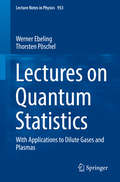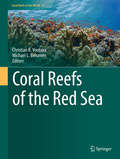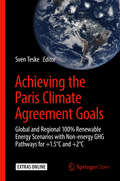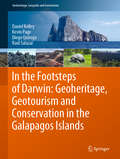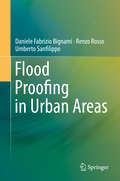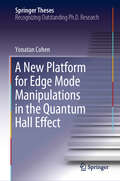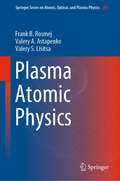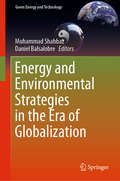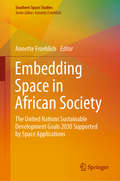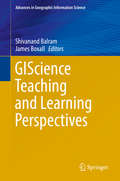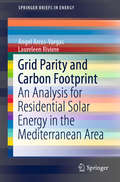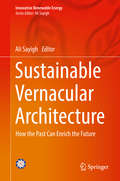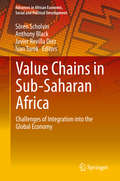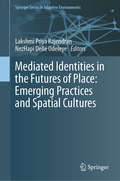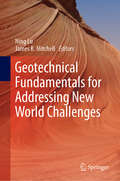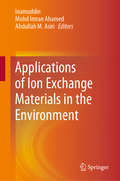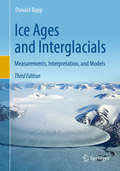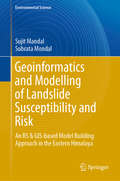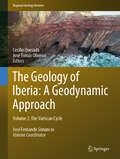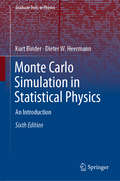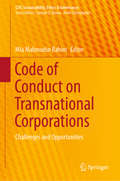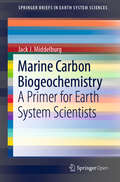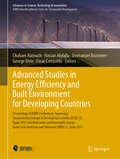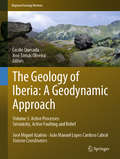- Table View
- List View
Lectures on Quantum Statistics: With Applications to Dilute Gases and Plasmas (Lecture Notes in Physics #953)
by Werner Ebeling Thorsten PöschelMost of the matter in our universe is in a gaseous or plasma state. Yet, most textbooks on quantum statistics focus on examples from and applications in condensed matter systems, due to the prevalence of solids and liquids in our day-to-day lives. In an attempt to remedy that oversight, this book consciously focuses on teaching the subject matter in the context of (dilute) gases and plasmas, while aiming primarily at graduate students and young researchers in the field of quantum gases and plasmas for some of the more advanced topics. The majority of the material is based on a two-semester course held jointly by the authors over many years, and has benefited from extensive feedback provided by countless students and co-workers. The book also includes many historical remarks on the roots of quantum statistics: firstly because students appreciate and are strongly motivated by looking back at the history of a given field of research, and secondly because the spirit permeating this book has been deeply influenced by meetings and discussions with several pioneers of quantum statistics over the past few decades.
Coral Reefs of the Red Sea (Coral Reefs of the World #11)
by Christian R. Voolstra Michael L. BerumenThis volume is a complete review and reference work for scientists, engineers, and students concerned with coral reefs in the Red Sea. It provides an up-to-date review on the geology, ecology, and physiology of coral reef ecosystems in the Red Sea, including data from most recent molecular studies. The Red Sea harbours a set of unique ecological characteristics, such as high temperature, high alkalinity, and high salinity, in a quasi-isolated environment. This makes it a perfect laboratory to study and understand adaptation in regard to the impact of climate change on marine ecosystems. This book can be used as a general reference, guide, or textbook.
Achieving the Paris Climate Agreement Goals: Global and Regional 100% Renewable Energy Scenarios with Non-energy GHG Pathways for +1.5°C and +2°C
by Sven Teske<p>This open access book presents detailed pathways to achieve 100% renewable energy by 2050, globally and across ten geographical regions. Based on state-of-the-art scenario modelling, it provides the vital missing link between renewable energy targets and the measures needed to achieve them. Bringing together the latest research in climate science, renewable energy technology, employment and resource impacts, the book breaks new ground by covering all the elements essential to achieving the ambitious climate mitigation targets set out in the Paris Climate Agreement. For example, sectoral implementation pathways, with special emphasis on differences between developed and developing countries and regional conditions, provide tools to implement the scenarios globally and domestically. Non-energy greenhouse gas mitigation scenarios define a sustainable pathway for land-use change and the agricultural sector. Furthermore, results of the impact of the scenarios on employment and mineral and resource requirements provide vital insight on economic and resource management implications. <p>The book clearly demonstrates that the goals of the Paris Agreement are achievable and feasible with current technology and are beneficial in economic and employment terms. It is essential reading for anyone with responsibility for implementing renewable energy or climate targets internationally or domestically, including climate policy negotiators, policy-makers at all levels of government, businesses with renewable energy commitments, researchers and the renewable energy industry.</p>
In the Footsteps of Darwin: Geoheritage, Geotourism and Conservation in the Galapagos Islands (Geoheritage, Geoparks and Geotourism)
by Daniel Kelley Kevin Page Diego Quiroga Raul SalazarThis book provides the first-ever overview of and guide to the geological setting and related features of the famous, volcanically active Galapagos Islands, as well as an in-depth analysis of the setting’s relationship to the region’s unique and iconic ecology, and its conservation. Further, it provides an introduction to human settlement and activity on the islands, including the transition from subsistence to a fishing economy and more recently tourism, all in the context of increasingly restrictive conservation regulations. Importantly, the book also explores the development of the concept and practice of sustainable development across the islands as a framework for future economic development, pursuing an approach that reconciles the needs of the resident population with conservation of this fragile environment.The book is intended for a broad readership, from those engaged in geological and ecological studies, college and university educators and conservation practitioners, to more general visitors to the islands.
Flood Proofing in Urban Areas
by Daniele Fabrizio Bignami Renzo Rosso Umberto SanfilippoFlood control in urban areas can be feasibly and cost-effectively enhanced by implementing flood proofing approaches to risk reduction in the context of environmental and land-use planning and management. Indeed, flood proofing makes it possible to improve, integrate and in some cases even replace traditional measures for flood control, reducing the vulnerability and increasing the resilience of buildings and infrastructures.This book begins by reviewing the physics of stability and instability of both human beings and buildings under flood conditions, together with criteria and models (both conventional and innovative) for assessing flood strains. In turn, it presents a range of flood proofing concepts and techniques, together with a complete and updated classification of related methods and devices. This provides a user-friendly tool to help identify appropriate solutions to real-world problems for each specific risk scenario.In particular, the book focuses on temporary flood proofing techniques, given their ability to deliver effective performance at low costs. Lastly, it features an overview of norms, guidelines and laboratory recommendations that are currently being adopted in various countries with regard to flood proofing devices and testing procedures.The purpose of this book is essentially to encourage authorities, stakeholders, technicians and end users to successfully develop flood proofing solutions that can reduce flood risk in a pragmatic manner. In addition, the authors hope to inspire researchers, manufacturers and designers (engineers, architects, urban planners and urban managers) to pursue further advances in this key sector of public and private safety in urban areas.
A New Platform for Edge Mode Manipulations in the Quantum Hall Effect (Springer Theses)
by Yonatan CohenIn the last several decades, the quantum Hall effect has provided a remarkable platform for manipulating one-dimensional electronic modes and investigating fundamental physical phenomena. However, certain limitations make it difficult for various kinds of interesting modes structures to be formed using this platform. One example is the so called helical mode structure, in which two one-dimensional, counter propagating modes have opposite spins and thus spin and momentum are locked. Such helical modes have lately attracted significant interest, since, when coupled to a conventional superconductor, they are expected to manifest topological superconductivity and host Majorana zero modes. Even more interesting are fractional helical modes, which open the way for realizing generalized parafermionic zero modes. Possessing non-abelian exchange statistics, these quasiparticles may serve as building blocks in topological quantum computing. Here we present a new platform for manipulating integer and fractional quantum Hall edge modes, which allows the formation of robust one-dimensional helical as well as fractional helical modes. The platform is based on a carefully designed double-quantum-well structure in a GaAs based system hosting two electronic sub-bands in the quantum Hall effect regime. By electrostatic gating of different areas of the structure, counter-propagating integer, as well as fractional, edge modes with opposite spins are formed and their spin protection is verified. Beyond the formation of helical modes, the new platform can serve as a rich playground for new research. Some new possibilities include the artificial induction of compounded fractional edge modes and the construction of new edge mode-based interferometers.
Plasma Atomic Physics (Springer Series on Atomic, Optical, and Plasma Physics #104)
by Frank B. Rosmej Valery A. Astapenko Valery S. LisitsaPlasma Atomic Physics provides an overview of the elementary processes within atoms and ions in plasmas, and introduces readers to the language of atomic spectra and light emission, allowing them to explore the various and fascinating radiative properties of matter. The book familiarizes readers with the complex quantum-mechanical descriptions of electromagnetic and collisional processes, while also developing a number of effective qualitative models that will allow them to obtain adequately comprehensive descriptions of collisional-radiative processes in dense plasmas, dielectronic satellite emissions and autoionizing states, hollow ion X-ray emissions, polarized atoms and ions, hot electrons, charge exchange, atomic population kinetics, and radiation transport. Numerous applications to plasma spectroscopy and experimental data are presented, which concern magnetic confinement fusion, inertial fusion, laser-produced plasmas, and X-ray free-electron lasers’ interaction with matter. Particular highlights include the development of quantum kinetics to a level surpassing the almost exclusively used quasi-classical approach in atomic population kinetics, the introduction of the recently developed Quantum-F-Matrix-Theory (QFMT) to study the impact of plasma microfields on atomic populations, and the Enrico Fermi equivalent photon method to develop the “Plasma Atom”, where the response properties and oscillator strength distribution are represented with the help of a local plasma frequency of the atomic electron density.Based on courses held by the authors, this material will assist students and scientists studying the complex processes within atoms and ions in different kinds of plasmas by developing relatively simple but highly effective models. Considerable attention is paid to a number of qualitative models that deliver physical transparency, while extensive tables and formulas promote the practical and useful application of complex theories and provide effective tools for non-specialist readers.
Energy and Environmental Strategies in the Era of Globalization (Green Energy and Technology)
by Muhammad Shahbaz Daniel BalsalobreThis book provides readers with cutting-edge techniques that can be applied to energy and environmental economics. Further, it highlights the effects that both globalization and economic growth have on the environment. In addition to offering a broader perspective on the relationship between environmental pollution, energy consumption and economic growth, the book studies the relationship between economic growth and environmental damage by drawing on the theoretical hypothesis of the Environmental Kuznets Curve. The book presents new econometric techniques and innovative approaches to the study of the energy economy. Accordingly, it can be used to help analyse the current state of the energy economy, the environment and globalization, and can serve as a theoretical reference manual for doctoral students and academics seeking new analytical techniques.
Embedding Space in African Society: The United Nations Sustainable Development Goals 2030 Supported by Space Applications (Southern Space Studies)
by Annette FroehlichThis book provides a detailed insight into how space and its applications are embedded, and can be further embedded, into African society in support of the SDGs, while taking into account the specific features, needs, and diversity of that society.Contributions drawn from across the continent and further afield provide analyses of the particular social situations in a variety of different African countries and regions, and highlight areas where space applications support the SDGs, and where they can further do so. The chapters cover a wide array of relevant and timely topics including basic needs like water quality, education, and capacity building, as well as financial, security, and legal aspects, together with facets of space technologies and infrastructure in Africa. Embedding Space in African Society will be of great interest to students and professionals in sustainable development, governance, and space studies.
GIScience Teaching and Learning Perspectives (Advances in Geographic Information Science)
by Shivanand Balram James BoxallThis volume uniquely links educational theories and the practice of GIScience in higher education contexts to guide classroom practice, present effective practical implementations from peers, and provide resources and strategies for effective teaching methods. The book offers a comprehensive exploration of GIScience education, including current trends and future educational needs in GIScience, and will act as a resource to prepare learners for a world that demands more intensive investment in present-day education and technological literacy. Additionally, the indirect benefit of merging the fragmented literature on GIScience literacy will provide a basis to examine common techniques and enable a new wave of research more rooted in learning theories. In ten chapters, the book is designed to attract an audience from geographic information systems science, geomatics, spatial information science, cartography, information technology, and educational technology as focus disciplines.
Grid Parity and Carbon Footprint: An Analysis For Residential Solar Energy In The Mediterranean Area (SpringerBriefs in Energy)
by Ángel Arcos-Vargas Laureleen RiviereThis book analyses the economic and environmental aspects of installing photovoltaic facilities for residential electricity users and determines whether the installation of photovoltaic units “behind the meter” makes sense, and if so, the best economic size to install. It explores the use of photovoltaic capacity to meet electricity requirements by generating enough for immediate use without feeding surplus electricity into the grid and without using storage. The authors illustrate this approach by examining various power photovoltaic capacities in locations such as Marseille, Madrid and Seville, which use hourly demand data provided by smart meters. They also show the possibility of developing energy self-consumption compatible with the operation of the network, making use of information from smart meters. Discussing how photovoltaic facilities are profitable from both an economic and an environmental point of view, this book is a valuable resource for researchers and private investors. It is also of interest to practitioners and academics, as the results presented are of importance for the near future.
Sustainable Vernacular Architecture: How the Past Can Enrich the Future (Innovative Renewable Energy)
by Ali SayighThis book discusses applying vernacular strategies to modern architectural design to adhere to basic green principles of energy efficiency and materials utilization. Written from an international perspective, chapters present the perspectives and experiences of architects and engineers from across the globe. Historically successful approaches are integrated with modern design concepts to create novel, sustainable, and resource conscious solutions. The scope of topics covered include natural ventilation, cooling and heating, daylight and shading devices, and green micro-climate and functional facades, making this a useful reference for a wide range of researchers and workers in the built environment.Covers the most up-to-date research developments, best practices, and innovations from countries all over the globe;Presents the latest research in vernacular architecture and sustainable building;Contains case studies and examples to enhance practical application of the technologies presented.
Value Chains in Sub-Saharan Africa: Challenges of Integration into the Global Economy (Advances in African Economic, Social and Political Development)
by Ivan Turok Sören Scholvin Anthony Black Javier Revilla DiezDevelopment largely depends on how given places participate in global economic processes.The contributions to this book address various features of the integration of sub-Saharan Africa into the world economy via value chains, so as to explain corresponding challenges and opportunities. The book deals with five issues that have not been covered adequately in scientific debates: first, policies are essential to promote value chains and increase their impact on development; second, value chains are diverse, and the variance between them has major economic and political implications; third, regional value chains appear to constitute a viable alternative to global ones (or, at least, are complementary to them), promising better developmental outcomes for the Global South; fourth, political and socio-economic factors are important considerations for a complete assessment of value chains; fifth, cities and city regions are also crucial objects of study in seeking to achieve a comprehensive assessment of value chains.
Mediated Identities in the Futures of Place: Emerging Practices and Spatial Cultures (Springer Series in Adaptive Environments)
by Lakshmi Priya Rajendran NezHapi Dellé OdeleyeThis book examines the emerging problems and opportunities that are posed by media innovations, spatial typologies, and cultural trends in (re)shaping identities within the fast-changing milieus of the early 21st Century.Addressing a range of social and spatial scales and using a phenomenological frame of reference, the book draws on the works of Heidegger, Merleau-Ponty and Don Hide to bridge the seemingly disparate, yet related theoretical perspectives across a number of disciplines. Various perspectives are put forward from media, human geography, cultural studies, technologies, urban design and architecture etc. and looked at thematically from networked culture and digital interface (and other) perspectives.The book probes the ways in which new digital media trends affect how and what we communicate, and how they drive and reshape our everyday practices. This mediatization of space, with fast evolving communication platforms and applications of digital representations, offers challenges to our notions of space, identity and culture and the book explores the diverse yet connected levels of technology and people interaction.
Geotechnical Fundamentals for Addressing New World Challenges (Springer Series in Geomechanics and Geoengineering)
by Ning Lu James K. MitchellThis single-volume thoroughly summarizes advances in the past several decades and emerging challenges in fundamental research in geotechnical engineering. These fundamental research frontiers are critically reviewed and described in details in lights of four grand challenges our society faces: climate adaptation, urban sustainability, energy and material resources, and global water resources. The specific areas critically reviewed, carefully examined, and envisioned are: sensing and measurement, soil properties and their physics roots, multiscale and multiphysics processes in soil, geochemical processes for resilient and sustainable geosystems, biological processes in geotechnics, unsaturated soil mechanics, coupled flow processes in soil, thermal processes in geotechnical engineering, and rock mechanics in the 21st century.
Applications of Ion Exchange Materials in the Environment
by Inamuddin Mohd Imran Ahamed Abdullah M. AsiriThis book presents the applications of ion-exchange materials in the area of environmental analysis and treatment. It includes chapters on applications of organic, inorganic and composite ion exchange materials and hexacyanoferrates in various fields such as chemical and biochemical separations, water purification, removal of harmful impurities, dyes and cationic and anionic complexes. This title is a highly valuable source of knowledge on ion-exchange materials and their applications suitable for postgraduate students and researchers but also to industrial R&D specialists in chemistry, chemical, and biochemical technology. Additionally, this book will provide an in-depth knowledge of ion-exchange column and operations suitable for engineers and industrialists.
Ice Ages and Interglacials: Measurements, Interpretation, and Models (Springer Praxis Books. Environmental Sciences Ser.)
by Donald RappThis book provides a detailed review of terminations of ice ages, including a very attractive theory based on dust deposits on ice sheets. While other books on ice ages are mostly short, popular, and non-technical, the only book that attempts to deal with the broad issues of what we know about past ice ages and why they occur is the book by Muller and MacDonald (M&M), published by Praxis. However, despite its many good features, this book suffers from an inordinate emphasis on spectral analysis, a lack of coverage of new data, and a very confusing sequence of chapters. As a result, the data and theory are so intimately entwined that it is difficult to separate one from the other. This volume provides an independent and comprehensive summary of the latest data, theories and analysis. This third edition of what has become the premier reference and sourcebook on ice ages addresses recent topics, and includes new references, new data, and a totally new, greatly expanded treatment of terminations of ice ages.
Geoinformatics and Modelling of Landslide Susceptibility and Risk: An RS & GIS-based Model Building Approach in the Eastern Himalaya (Environmental Science and Engineering)
by Sujit Mandal Subrata MondalThis book discusses various statistical models and their implications for developing landslide susceptibility and risk zonation maps. It also presents a range of statistical techniques, i.e. bivariate and multivariate statistical models and machine learning models, as well as multi-criteria evaluation, pseudo-quantitative and probabilistic approaches. As such, it provides methods and techniques for RS & GIS-based models in spatial distribution for all those engaged in the preparation and development of projects, research, training courses and postgraduate studies. Further, the book offers a valuable resource for students using RS & GIS techniques in their studies.
The Geology of Iberia: Volume 2: The Variscan Cycle (Regional Geology Reviews)
by Cecilio Quesada José Tomás OliveiraTaking a new global approach, this unique book provides an updated review of the geology of Iberia and its continental margins from a geodynamic perspective. Owing to its location close to successive plate margins, Iberia has played a pivotal role in the geodynamic evolution of the Gondwanan, Rheic, Pangea, Tethys s.l. and Eurasian plates over the last 600 Ma of Earth's history. The geological record starts with the amalgamation of Gondwana in the Neoproterozoic succeeded by the rifting and spreading of the Rheic ocean; its demise, which led to the amalgamation of Pangea in the late Paleozoic; the rifting and spreading of several arms of the Neotethys ocean in the Mesozoic Era and their ongoing closure, which was responsible for the Alpine orogeny. The significant advances in the last 20 years have attracted international research interest in the geology of the Iberian Peninsula. This volume presents the most comprehensive, careful and updated description of the variscan cycle in Iberia. This volume focuses in the different geological events since the Cambrian-Early Ordovician rift until the late variscan orocline formations including magmatic and metamorphic evolution.
Monte Carlo Simulation in Statistical Physics: An Introduction (Graduate Texts in Physics #Vol. 80)
by Dieter W. Heermann Kurt BinderThe sixth edition of this highly successful textbook provides a detailed introduction to Monte Carlo simulation in statistical physics, which deals with the computer simulation of many-body systems in condensed matter physics and related fields of physics and beyond (traffic flows, stock market fluctuations, etc.). Using random numbers generated by a computer, these powerful simulation methods calculate probability distributions, making it possible to estimate the thermodynamic properties of various systems. The book describes the theoretical background of these methods, enabling newcomers to perform such simulations and to analyse their results. It features a modular structure, with two chapters providing a basic pedagogic introduction plus exercises suitable for university courses; the remaining chapters cover major recent developments in the field.This edition has been updated with two new chapters dealing with recently developed powerful special algorithms and with finite size scaling tools for the study of interfacial phenomena, which are important for nanoscience. Previous editions have been highly praised and widely used by both students and advanced researchers.
Code of Conduct on Transnational Corporations: Challenges and Opportunities (CSR, Sustainability, Ethics & Governance)
by Mia Mahmudur RahimThis book explores the challenges and opportunities presented by the formulation of a global code of conduct for transnational corporations. It assesses the current state of research on global regulations intended to enhance the social responsibility of transnational corporations, and provides a platform for future research. In particular the book examines frameworks and instruments for regulating social responsibility, reviews recent developments concerning the proposed UN Code of Conduct on Transnational Corporations, and provides insights into international civil society groups’ movements in pursuit of a code of conduct. In a separate chapter the book discusses theoretical issues in regulating transnational corporations, and investigates their legitimacy and behavioral dynamics. In closing, the book discusses alternatives to a global code of conduct, the impact of sovereign power in the era of globalization, “soft regulations,” and the feasibility and normative efficacy of enforcing regulations.
Code of Conduct on Transnational Corporations: Challenges and Opportunities (CSR, Sustainability, Ethics & Governance)
by Mia Mahmudur RahimThis book explores the challenges and opportunities presented by the formulation of a global code of conduct for transnational corporations. It assesses the current state of research on global regulations intended to enhance the social responsibility of transnational corporations, and provides a platform for future research. In particular the book examines frameworks and instruments for regulating social responsibility, reviews recent developments concerning the proposed UN Code of Conduct on Transnational Corporations, and provides insights into international civil society groups’ movements in pursuit of a code of conduct. In a separate chapter the book discusses theoretical issues in regulating transnational corporations, and investigates their legitimacy and behavioral dynamics. In closing, the book discusses alternatives to a global code of conduct, the impact of sovereign power in the era of globalization, “soft regulations,” and the feasibility and normative efficacy of enforcing regulations.
Marine Carbon Biogeochemistry: A Primer For Earth System Scientists (SpringerBriefs in Earth System Sciences)
by Jack J. MiddelburgThis open access book discusses biogeochemical processes relevant to carbon and aims to provide readers, graduate students and researchers, with insight into the functioning of marine ecosystems. A carbon centric approach has been adopted, but other elements are included where relevant or needed. The book focuses on concepts and quantitative understanding of primary production, organic matter mineralization and sediment biogeochemistry. The impact of biogeochemical processes on inorganic carbon dynamics and organic matter transformation are also discussed.
Advanced Studies in Energy Efficiency and Built Environment for Developing Countries: Proceedings of IEREK Conferences: Improving Sustainability Concept in Developing Countries (ISCDC-2), Egypt 2017 and Alternative and Renewable Energy Quest in Architecture and Urbanism (AREQ-2), Spain 2017 (Advances in Science, Technology & Innovation)
by Chaham Alalouch Hassan Abdalla Emmanuel Bozonnet George Elvin Oscar CarracedoThis edited volume consists of three parts. It is a culmination of selected research papers presented at the second version of the international conference on Improving Sustainability Concept in Developing Countries (ISCDC) and the second version of the international conference on Alternative and Renewable Energy Quest in Architecture and Urbanism (AREQ), organized by IEREK in Egypt, 2017. It discusses major environmental issues and challenges which threaten our future. These include climate change impact, environmental deterioration, increasing demand for energy and new approaches for alternative renewable energy sources which became a necessity for survival. In addition to addressing the different environmental issues witnessed today, research presented in this book stressed on the need of sustainably shaping buildings and cities using renewable energy sources. Topics included in this book are (1) Resilience in the Built Environment, (2) Design for energy-efficient architecture and (3) Alternative and Renewable Energy Resources Quest in Architecture and Urbanism. The book is of interest to researchers and academicians who continuously aim to update their knowledge in these fields, as well as decision makers needing the enough knowledge to carry out the right decisions towards the benefit of the environment and society.
The Geology of Iberia: Volume 5: Active Processes: Seismicity, Active Faulting and Relief (Regional Geology Reviews)
by Cecilio Quesada José Tomás OliveiraAdopting a global approach, this unique book provides an updated review of the geology of Iberia and its continental margins from a geodynamic perspective. Owing to its location close to successive plate margins, Iberia has played a pivotal role in the geodynamic evolution of the Gondwanan, Rheic, Pangea, Tethys and Eurasian plates over the last 600 Ma of Earth’s history. The geological record starts with the amalgamation of Gondwana in the Neoproterozoic, which was succeeded by the rifting and spreading of the Rheic ocean; its demise, which led to the amalgamation of Pangea in the late Paleozoic; and the rifting and spreading of several arms of the Neotethys ocean in the Mesozoic Era and their ongoing closure, which was responsible for the Alpine orogeny. The significant advances in the last 20 years have increasingly attracted international interest in exploring the geology of the Iberian Peninsula. This final volume of the Geology of Iberia focuses on the active geological processes in Iberia including seismicity and active faulting as well as the modern landscapes in the Iberian Peninsula.
